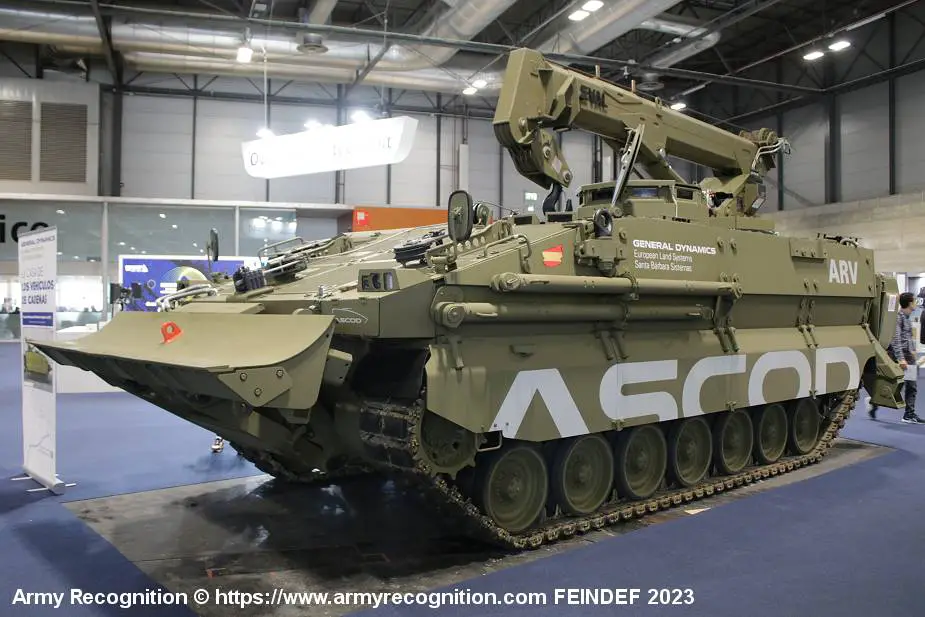At the international FEINDEF 2023 defense exhibition in Madrid, Spain, General Dynamics European Land Systems (GDELS) - Santa Bárbara Sistemas debuted a new variant of the ASCOD tracked armored vehicle, the Armored Recovery Vehicle (ARV).
Follow Army Recognition on Google News at this link

At FEINDEF 2023, a defense exhibition in Spain, GDELS unveils its new ASCOD tracked ARV Armored Recovery Vehicle. (Picture source Army Recognition)
The ASCOD ARV showcased by GDELS at FEINDEF was designed for the Philippine army. This vehicle is specifically designed for recovery missions, tasked with retrieving and towing damaged or immobilized tanks in combat zones. With its heavy-duty winches, cranes, and other essential equipment, the ASCOD ARV is poised to execute these operations with remarkable efficiency.
In addition to recovery, ARV vehicles have a role in performing basic repairs on the battlefield. Although they aren't mobile workshops, they often carry essential tools and spare parts that can help in making quick fixes to damaged vehicles. This can allow the vehicles to return to action or move them to a more secure location where more comprehensive repairs can be carried out.
Another important function is to provide maintenance support in the field when it's not practical or feasible to return the vehicles to a permanent facility. The overarching goal is to maintain the operational readiness of the unit and minimize downtime, enhancing the effectiveness of the tank unit as a whole.
The ASCOD Armored Recovery Vehicle (ARV) is a modern solution for the maintenance, recovery, and repair of medium-weight combat vehicles. Its primary application is on contemporary battlefields, where it plays an essential role in keeping the combat unit operational.
One of the distinct features of the ASCOD ARV is its stabilization system, which helps maintain the balance of the vehicle, especially when performing tasks like lifting or towing, contributing to its overall operational efficiency.
Additionally, the ASCOD ARV is equipped with a crane and a winch. The crane serves a critical purpose in lifting damaged components of combat vehicles, while the winch allows the vehicle to tow disabled combat vehicles away from the frontline or dangerous areas, ensuring the safety of the crew and equipment.
Furthermore, it features a dozer blade. This helps in clearing obstacles or making hasty field fortifications, further adding to its versatility on the battlefield. It also has a potential application in helping to free stuck vehicles.
The ASCOD ARV is designed to operate on a medium-weight platform, with a maximum load classification (MLC) of 50. This implies that it is capable of performing recovery and repair operations for vehicles of similar or lighter weight, making it a flexible choice for diverse combat situations.
The ARV variant of the ASCOD provides the same levels of mobility and protection across its platform variants. the vehicle as a crew of three including a driver, commander and one mechanic. It is powered by MTU V-8 600kW or SCANIA V-8 810kW engine, coupled to an automatic Renk transmission with integrated reversing and steering gear, 6-speed. The ASCOD uses a torsion bar and trailing arm-type suspension with seven dual rubber-tired road wheels on either side, a drive sprocket at the front, an idler at the rear, and three track-return rollers.
The new generation ASCOD is designed with an integrated approach to protection. Its fundamental structure comprises an all-welded steel armor hull, providing a solid foundation of resistance. The ASCOD enhances its ballistic protection through a modular system, capable of reaching up to level 6 according to the STANAG 4569 standard. Furthermore, the ASCOD offers premier defense against mine and IED blasts. This includes a safeguarded floor structure designed to prevent injuries to the crew members' legs and protect against secondary internal projectiles.















